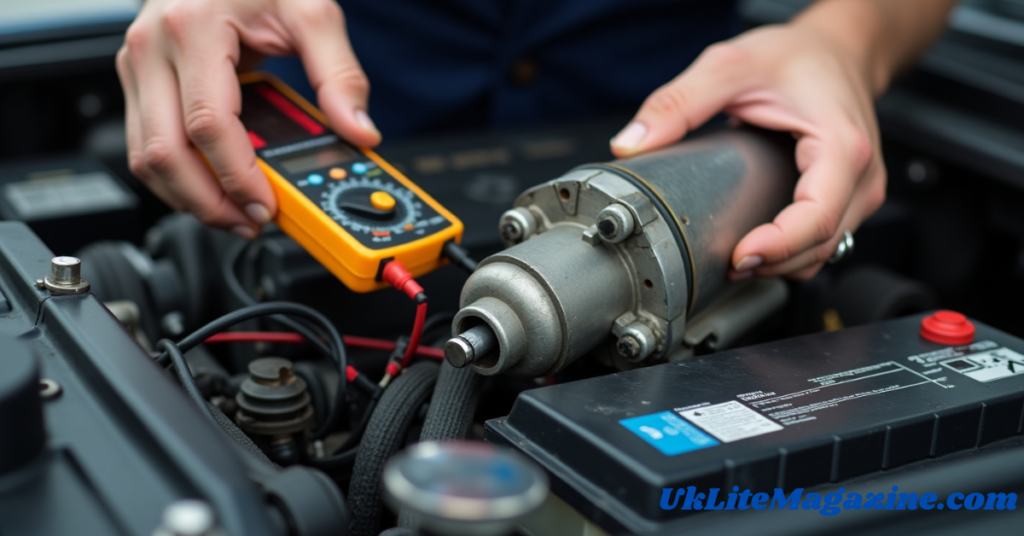A car’s electrical system is complex, and when issues arise, it can be difficult to pinpoint the root cause. One common question many car owners ask is, “Can a bad starter drain a battery?” The short answer is yes—a faulty starter can lead to battery drainage, among other problems. In this article, we’ll explain how a bad starter affects your battery, the causes behind it, how to diagnose the issue, and solutions to fix it.
How a Bad Starter Can Drain a Battery
The starter motor is responsible for cranking the engine when you turn the ignition key. If it malfunctions, it may not function efficiently, drawing excessive power from the battery. Here’s how a bad starter drains your battery:
- Continuous Power Draw – If the starter solenoid is stuck, it keeps drawing power even when the engine is off.
- Repeated Failed Start Attempts – If your starter is faulty, multiple attempts to start the car drain the battery.
- Electrical Short Circuit – A defective starter can cause electrical shorts, which lead to battery drain.
- Increased Resistance – Over time, worn-out starter components cause resistance, making the starter pull more power than needed.
Common Causes of a Bad Starter Draining a Battery
Several factors contribute to a failing starter that drains the battery. Below are the most common causes:
| Cause | Explanation |
|---|---|
| Worn-out Starter Motor | Over time, the starter motor components degrade, requiring more power to operate. |
| Faulty Solenoid | A stuck solenoid can continue pulling power even when the car is off. |
| Corroded Electrical Connections | Dirty or corroded connections prevent proper power flow, causing excess battery drain. |
| Damaged Ignition Switch | If the ignition switch remains in the ‘on’ position, the starter stays engaged, draining power. |
| Short Circuit in Starter Wiring | A wiring fault can lead to continuous battery drainage. |
Signs of a Bad Starter Draining the Battery
Identifying the symptoms of a failing starter can help you address the issue before it leads to complete battery failure. Here are the key warning signs:
- Slow or No Crank – If your engine cranks slowly or not at all, the starter may be failing.
- Clicking Sound When Turning the Key – A clicking noise when starting the car often signals a faulty starter or battery.
- Burning Smell or Smoke – Overheating starter components can emit a burning odor.
- Frequent Need for Jump-Starts – If your battery frequently dies, the starter could be drawing excessive power.
- Lights Work but Car Won’t Start – If the dashboard lights turn on but the engine won’t crank, the starter is a likely culprit.
How to Diagnose a Bad Starter vs. a Bad Battery
Before assuming your battery is the issue, it’s important to diagnose whether the starter is actually at fault. Use the following methods:
| Test | Indication of Bad Starter | Indication of Bad Battery |
| Jump-Start Test | Car still won’t start after jump | Car starts after jump but dies later |
| Voltage Test | Battery voltage is normal (12.6V), but car won’t start | Battery voltage is below 12.4V |
| Tap the Starter | Car may start temporarily when tapping starter | No effect on battery function |
| Check Dashboard Lights | Lights turn on, but no crank | No lights or dim lights |
Solutions to Fix a Bad Starter
If you’ve determined that your starter is the cause of battery drain, here are some possible fixes:
1. Clean Corroded Connections
- Disconnect the battery before cleaning.
- Use a wire brush and baking soda solution to remove corrosion.
- Reconnect and check if the starter operates normally.
2. Check the Starter Relay
- A faulty relay may prevent power from reaching the starter.
- Replace the relay if it shows signs of damage.
3. Test and Replace the Solenoid
- If the solenoid is stuck, it can continue drawing power.
- A new solenoid can resolve this issue.
4. Inspect and Replace Wiring
- Look for damaged or frayed wiring that may be causing a short circuit.
- Replace any defective wires.
5. Replace the Starter Motor
- If the starter motor is completely worn out, replacing it is the best solution.
Preventing Future Starter Issues
To avoid dealing with starter-related battery drainage in the future, follow these preventive measures:
- Regular Battery Maintenance – Ensure your battery is in good condition to prevent excessive strain on the starter.
- Inspect Wiring & Connections – Periodically check electrical connections for corrosion or damage.
- Avoid Holding the Key Too Long – Prolonged cranking can overheat the starter and cause damage.
- Use Quality Replacement Parts – When replacing components, choose high-quality parts for longevity.
Conclusion
A bad starter can drain your battery, leading to starting issues and potential breakdowns. Identifying the problem early, understanding its causes, and applying the right solutions can save you from costly repairs. If you notice persistent battery drainage, slow cranking, or a clicking sound when trying to start your car, it’s best to diagnose and fix the issue promptly. Regular maintenance and timely replacements will help keep your car running smoothly.
Frequently Asked Questions (FAQs)
1. Can a bad starter cause a car battery to die overnight?
Yes, if the starter solenoid is stuck or there is a short circuit, it can continuously draw power and drain the battery overnight.
2. How can I tell if it’s my starter or battery causing the issue?
Perform a jump-start test. If the car starts after a jump but later dies, the battery is likely the issue. If it doesn’t start even after a jump, the starter is probably faulty.
3. Can I drive with a bad starter?
No, a failing starter can leave you stranded. If you suspect your starter is bad, get it checked and replaced as soon as possible.
4. How much does it cost to replace a starter?
The cost varies, but replacing a starter typically ranges between $200 to $600, depending on the vehicle model and labor costs.
5. What’s the average lifespan of a car starter?
A car starter usually lasts between 100,000 to 150,000 miles, but this depends on usage and maintenance.
By staying proactive and addressing starter issues early, you can avoid unexpected car troubles and keep your vehicle in top condition.

